Mindmapping Your Tradeshow Appearance
Sometimes it makes sense to visualize everything you are planning to do in your next tradeshow appearance. I thought it might fun to put the mindmapping to video and see how it went:

Sometimes it makes sense to visualize everything you are planning to do in your next tradeshow appearance. I thought it might fun to put the mindmapping to video and see how it went:

When I first got into the tradeshow industry back in ’02, table top exhibits were pretty cheap and boring. They were often small suitcase affairs that could be easily transported by one person and set up in just a couple of minutes. You’d fold it out, set it on a table, and often attach laminated images using Velcro tape. Or some exhibitors would cobble together small sample packs of their products with sell sheets or small ads in acrylic holders.
It wasn’t impressive or inspiring. But they were cheap, and easy to transport. So in a sense, they served a purpose.
Today, you can no doubt use much of those same table top exhibits. But there are a wide variety of table top exhibits that take things to the next level. Or three. Many of the new designs use materials such as fabric graphics (often backlit) that are more common in in-line and island exhibits. Prices have gone up, but so has quality and impact. Each exhibitor that’s sticking with a table top presentation has to decide if the extra cost is worth the impact.
Let’s take a look at a few table top exhibits:
Starting with what are called hybrids, the VK-1853 uses ‘to-the-edge’ silicon-edged graphics, an engineered aluminum frame and can pack in a small rollable case.
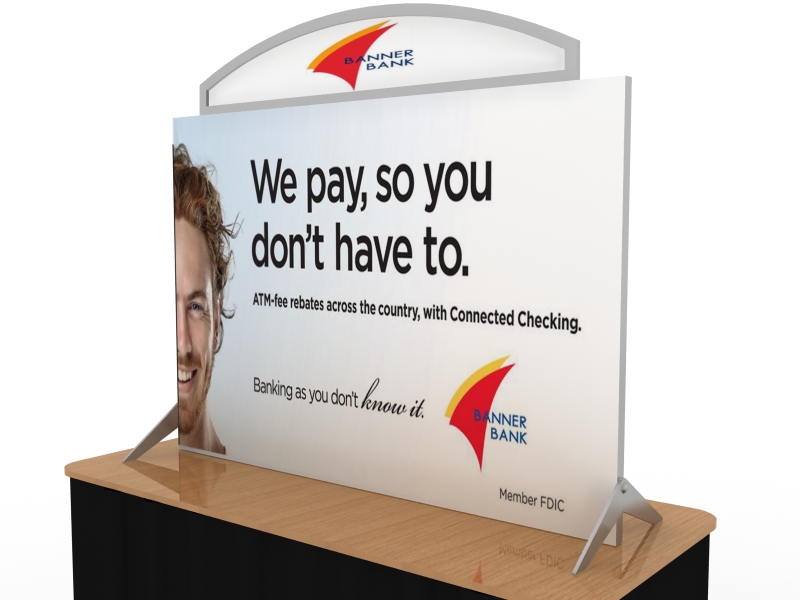
Another example of the hybrid exhibit is the VK-0005, which is essentially a SuperNova tool-less lightbox with shelves for product display.
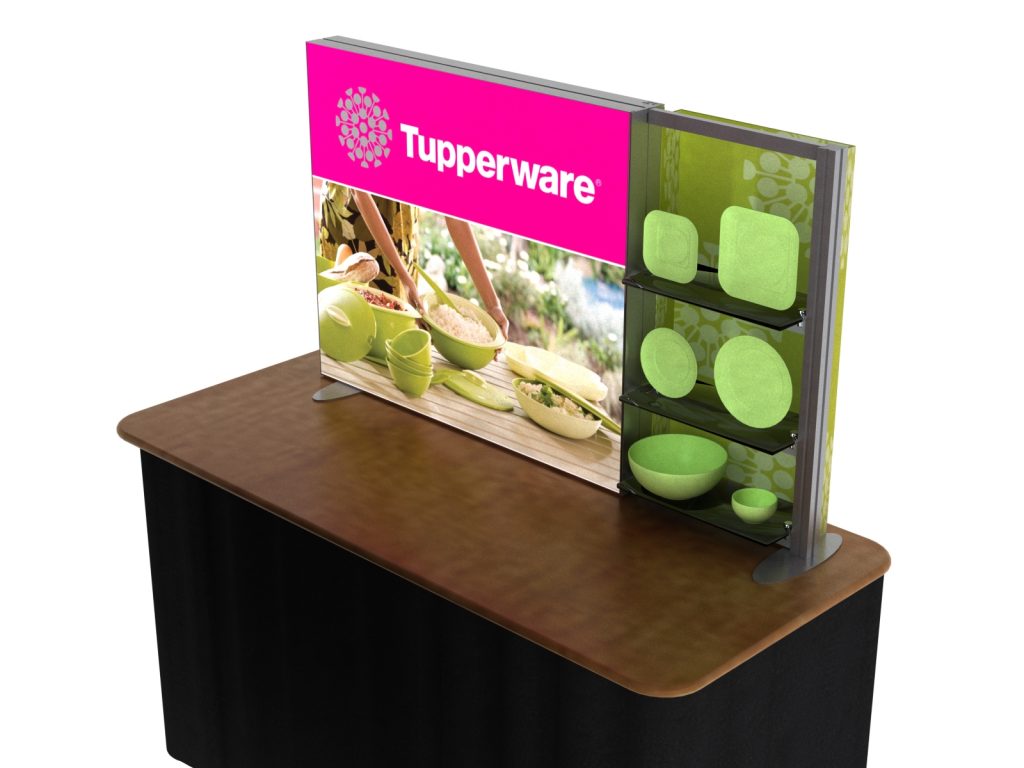
On to the lightweight tension fabric, there are many examples, including the TF-403 and TF-405, both featuring lightweight metal frames and large format tension fabric. The TF-405 comes with an S-shaped frame which, because of its unusual shape, tends to catch the eye.
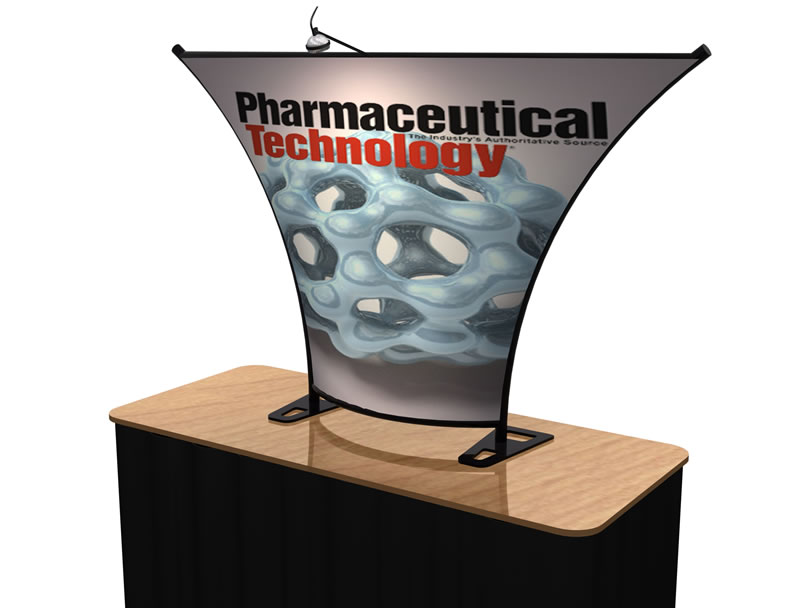
Moving on, there are a number of sustainably-engineered and produced table tops. One that catches the eye is the ECO-104T. And confirming that these are often shrunken versions of full-size in-lines, there are both 10×10 and 10×20 versions of this particular exhibit.
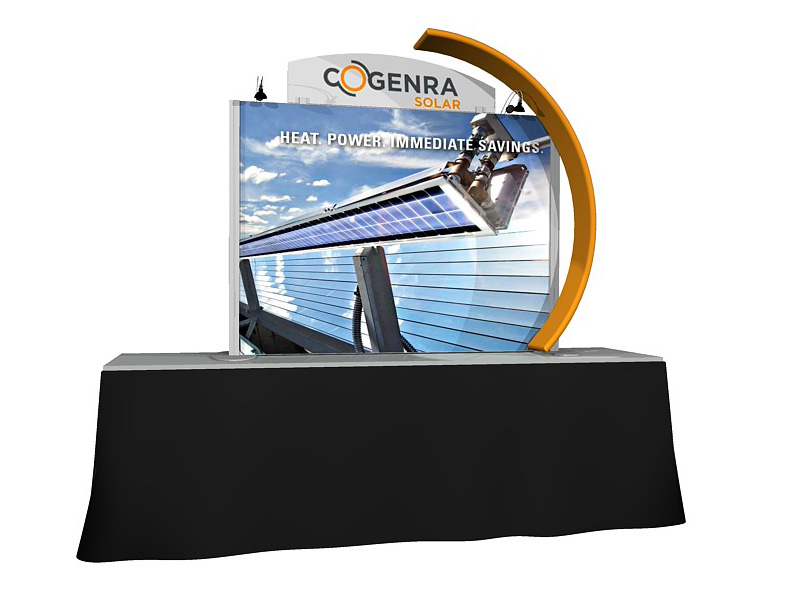
Another example of a sustainable exhibit is the TF-409, an Aero freestanding table top, which stands out with its double-circle design.
Folding table tops are probably associated with the vintage table tops, and the FT-05 is a good example of them. They are economical and easy to set up (as are all of these), and give a solid look.
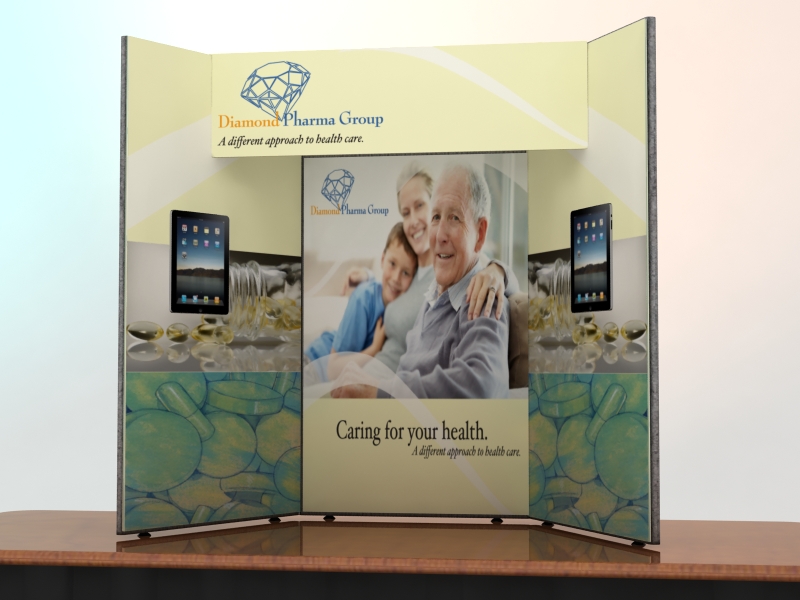
And finally, the FGS (Floating Graphic System) pop-ups come in a variety of configurations, all of which offer a variety of graphic placements for products and branding. Here’s the FG-03:
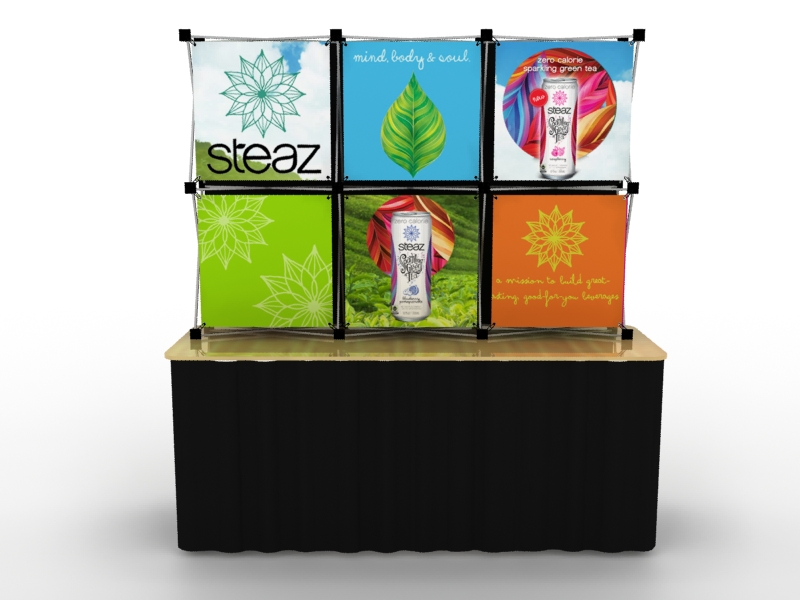
Table top exhibits come in all shapes and varieties and in a wide price range. Many shows that exhibitors want to go to are smaller and they don’t need a big exhibit, or even an in-line, which is a great opportunity to show off your company in an impressive light for a price that is light on your wallet.
Check our full line of table top exhibits here.
3D Exhibit Designer and Graphic Designer Jack Hale sits down to discuss the ins and outs of tradeshow exhibit design and graphic design on this week’s edition of TradeshowGuy Monday Morning Coffee. Take a look:
Check out Jack’s work and website at JB Hale Design.
This week’s ONE GOOD THING: Last year’s Sting and Shaggy release, 44/876.
You have literally a few seconds to catch a tradeshow attendee’s attention. You’ve been there: walking the show floor, heading across the hall. You see someone you know; you get distracted, you spill your coffee on your pants. There’s always something that keeps you from paying attention to the tradeshow exhibits around you.
Even highway billboards sometimes get more attention than your booth.
Which means that people are ignoring you. Not because you don’t have something good to offer. Not because you are slacking in the ‘look at us’ department. But if you’re doing just the average approach to getting attention, you’ll be, well, average when it comes to having people stop. What are some of the top ways to get attention?
Do something different. Unexpected. Unusual. I often point to the Kashi island exhibit that’s shown up at Natural Products Expo West in at least a couple of iterations the past few years. It’s simple, and it delivers a simple message. It invites people to stop and find out what it is. The design itself is unusual enough that it stops visitors.
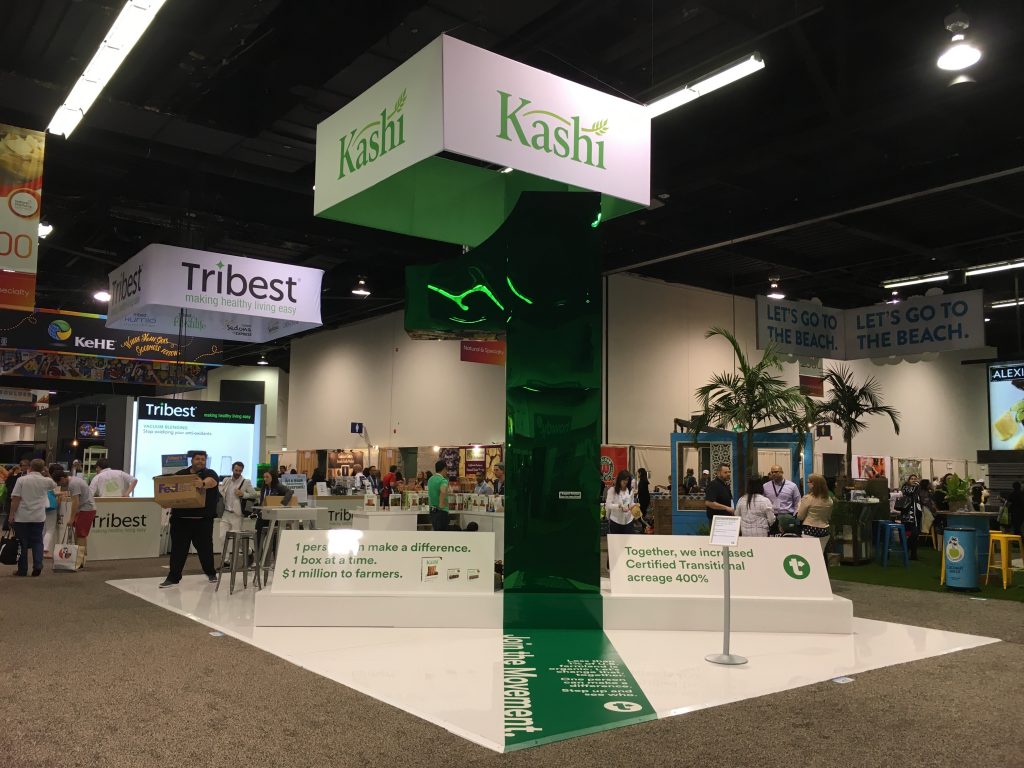
Hire a pro. A professional presenter knows how to stop people in their tracks, entertain them and deliver a powerful message in just a few moments.
Have something for them to do. Interactivity means, if the activity appeals to them (chance to win a prize or get a little mental engagement), they’ll stop. And of course a small crowd draws a bigger crowd.
Ask a great question. Take a tip from our pal Andy, who specializes in teaching this to his clients, there’s a lot to be said for knowing how to immediately engage with someone in a positive manner.
Offer a space for people to sit and charge their phones. This usually takes a bigger booth than just a small inline, which means you need a little space to spare. But if you can get random visitors to sit for ten minutes, offer them something valuable: a bottle of water, a chance to view a video about your company or product.
Lots of ways to capture a tradeshow attendee’s attention – it just takes a little planning and execution and you can be drawing them in.
Wear colorful branded clothing. Whether it’s a staff of two or three, or twenty, having colorful branded clothing will immediately let visitors know who’s working the booth and who’s a guest. Bright colors attract, so put your logo on the front and an enticing message on the back. And to change things up from day to day, create a different colored set with a different message for each day of the show, and make sure your crew coordinates. Bright colors, especially if they’re tied into your brand work well: yellow, red, orange, blue, fluorescent.
Setup a giant prop and invite people to take a photo. Could be anything: a mascot, a giant purse, a full-size model of one of your products (if it’s small, for instance); something that stops people in their tracks. I’ve seen mascot, angels, musicians, giant hanging props, exhibits made from bicycle frames and more. They all had one thing in common: they begged to have their picture taken.
Once that photo has been taken, invite the visitor to spread the word on social media and include the show hashtag to make sure the post gets seen. Offer prizes to people that photo and share online.
Give something away and offer an incentive to wear it. One way is to print up a few hundred t-shirts or hats with your logo along with a fun message and tell people that if they put it on right there, they can also take home another gift. And tell them if you catch them wearing it at an after-hours show (be specific as to which one), you’ll be giving away $50 bills to random shirt wearers. This type of promotion gets others involved and spreads the word about your booth and products throughout the show.
Have a unique exhibit that begs to be seen. Sounds straightforward, but to break out of the cookie-cutter mold, it takes a designer that’s willing to create something unique and wild and a company that’s willing to spend to make it a reality.
Give visitors something to DO. Interactivity goes a long way. At the NAB Show, there were several exhibitors that gave visitors a chance to learn new software by joining them for a free class. Not only are you drawing interested people in, you’re keeping them involved for up to an hour and showing them exactly how the product works.
Contests. Give people a chance to win something by guessing the number of beans in a jar, answering a quiz, spinning a wheel or something else increases the chance you’ll get visitors to stop at your booth. Make sure to engage them in a brief conversation to uncover their needs regarding your product.
Famous mugs. Lots of companies hire famous (or at least semi-well known) people to be a part of the show. Authors, speakers, sports stars, actors, and so on can all draw a crowd. Authors in particular, if they’re in your industry, can be a good draw if they have a new book out. I’ve seen dozens of people in line to pick up a free copy of a new book and get it signed by the author (and snap a selfie!), and I’ve waited in line to get a prop soft baseball signed by Hall of Famer Ozzie Smith.
Comment wall. I see these more and more. Ask a bold question or make a bold statement and invite people to chime in with their thoughts on a wall. Invite people to snap a photo of what they wrote and share it on social media (make sure the wall is branded and has the show hashtag on it).
Bring media production to your booth. Know someone that is a podcaster in the industry? Invite them to record a few episodes of their show in your booth, and make sure to provide some good guests for them, whether it’s people from your company, or others. The simple act of recording a show in your booth will make a lot of people stop. That’s a good time for your staff to engage those visitors politely to find out if they’re prospects.
If someone in your company has written a book, offer free copies of the book along with free printed photos with visitors and the author. This has worked great for years for Bob Moore of Bob’s Red Mill, one of our long-time clients at TradeshowGuy Exhibits. Every time they exhibit at the bigger expos, Bob spends time signing books and posing for photos while a photographer takes photos and has them printed up in a few moments for the visitor.
There are literally countless ways to draw crowds to your booth. It all boils down to creativity and execution. What can you do to improve the traffic at your next show?
Are you faced with authors call “writer’s block” when it comes to coming up with ideas for your next tradeshow promotion? Or need to come up with a unique exhibit design or presentation that perfectly fits your company brand?
I wish I had an answer. You know, like the Staples “EASY” button. But it ain’t that easy. Not if you want an idea that can be fully executed and give you remarkable results.
So where do ideas come from? Ideas that actually work?
There are several places to look for and generate ideas, so let’s go over a few.
At your next tradeshow, whether you are an exhibitor or an attendee, take some time to walk the floor and see what others have done. There are going to be so many ideas that you won’t be able to capture them all. And to take it one step further, if you see an idea you like, imagine how it would work if you folded that presentation idea into your brand and products. And you know that anything you see at a tradeshow had to go through a lot to make it to the floor. It had to be created as a concept, then discussed at length to see what would work and what wouldn’t. Then a 3D designer had to determine how to put that concept into the real world. Then, once all parties had signed off on the idea and concept, it had to go to fabrication, where the builders had to figure out how to build it. Not always easy, especially if there are some unusual or outlandish ideas that need to be brought to life.
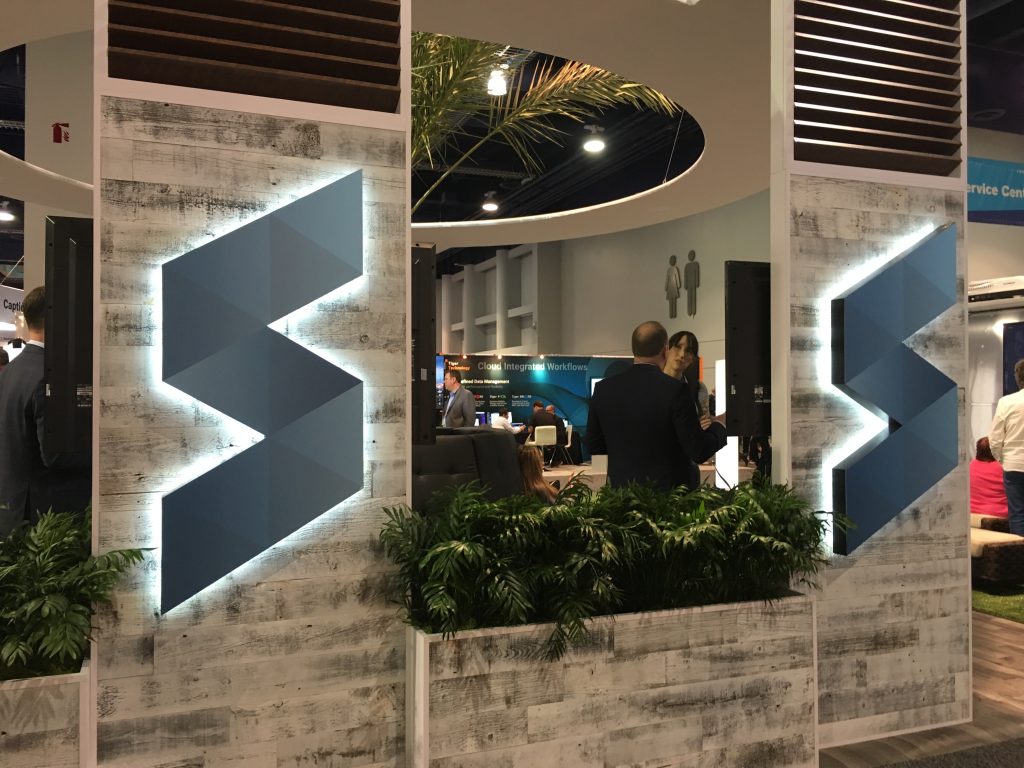
But remember, just because it was brought to life and used at a tradeshow doesn’t mean it actually worked, that it actually achieved what the creators thought it would achieve. Which means it’s also worth asking “how well did that work?” Probably the only way to find out for sure is to ask the exhibiting company after the show how it all went for them. But by doing that you might be tipping your hand that you’d like to use their idea for inspiration!
To see what is creative and actually works, pick up a copy of Exhibitor Magazine. To my way of thinking, all tradeshow marketing managers should get a subscription to this bible of the exhibit industry. Nearly every issue there is an in-depth look at tradeshow exhibits. Not only that, there is a breakdown of how the idea worked, how it fit with the company’s overall goals, what the results were, and often the cost. Even if the idea doesn’t exactly fit with your product or brand, use it to kickstart your own creative thinking.
Beyond Exhibitor Magazine, search online for creative tradeshow exhibit ideas. There are a lot of them floating around, and any one of them might be the inspiration you’re looking for.
Networking can do a lot of things. One thing it does well is spread good ideas. By talking to other exhibitors, designers, managers and executives in the industry is that no doubt they’ve all seen some memorable tradeshow exhibits along the way. Ask them what they recall, what they liked, and how it worked. Make notes. And if you get a great idea that leads to something, be sure to thank ‘em!
Creative thinking can often be generated in-house with a handful of people. You may have even been in a brainstorming session or three in your career. If done properly, they can be brief and productive.
Pick up a book on creative thinking and see where it takes you. One of my favorites is Thinkertoys by Michael Michalko. Worth the price no matter what you pay.
Any other books or ideas you like that help you creatively? Make a note and share!
I’ve been attending tradeshows for nearly twenty years. In looking back on photos from that era – the early ‘Naughts as the first ten years of this century are sometimes referred to – things look different. It’s often subtle, but what the photos from that era show is what’s NOT there. You have to look closely and compare the images from around 2003 – 2005 with images from today’s shows.
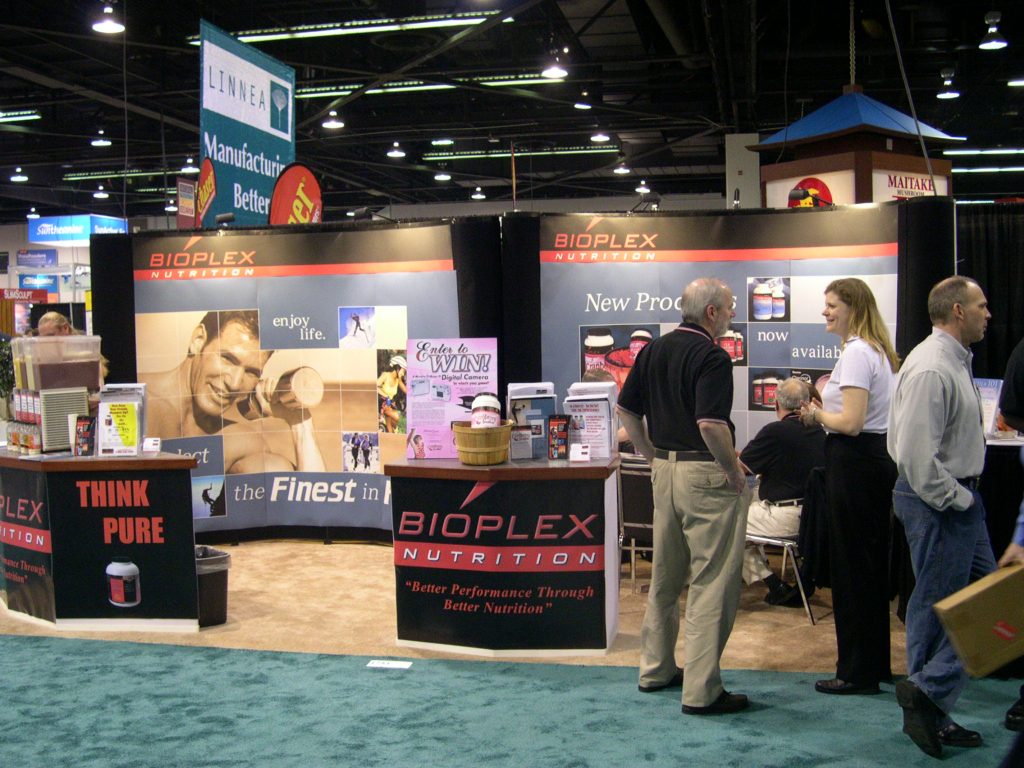
The big changes?
Video: Depending on the show, some are stark and blatantly obvious. For example, I saw so many large video walls at this year’s National Association of Broadcasters Show in Las Vegas I lost count. Big, small, portable banner-stand-like video walls, large walls used for training (Adobe and others), most of them extremely high quality.
Some smaller shows or different types of shows may not have the large video walls (or only a few), but my impression is that a majority of exhibits have large video monitors. These typically range from around 40” to as much as 70” and all show sharp images. It’s much easier to attach monitors on exhibit walls when the monitors are so slim compared to what was available a couple of decades ago.
Fabric Graphics: Printing on fabric has come so far, it’s hard to imagine what it was like at the turn of the century. Printers have gotten so much better and fabrics have also improved that in many cases what you’re seeing on the exhibit walls are fabric graphics printed with such depth and clarity it compares with top of the line paper printing.
LED lighting: Hand in hand with fabric graphics, the evolution of LED lighting has meant better lights for a fraction of the cost. Combine LED lights and an aluminum frame with fabric graphics and voila you have a fantastic-looking lightbox that shines!
Augmented Reality: I’ve only seen this a few times at tradeshows, but I think it’s going to spread. It’s showing up at museums and other permanent installations. Why not tradeshows?
3D Virtual tours: Again, not used so much these days, but check out the recent interview I did with Phil Gorski from Ova-Nee Productions and see what they’re doing in the tradeshow space. I can see this happening more and more to take the physical tradeshow to a larger audience in the digital world.
Virtual Reality: Not something that is taking over the tradeshow world, but it is definitely there and a smart exhibitor that chooses to use VR will plan to do it right. Here’s an interview I did with Foundry45‘s Dave Beck.
Interactive Touch Screens: Depending on the way you want your visitors to interact this can be a big benefit to help show off your company, products and people.
Charging Stations: At the turn of the century hardly anyone thought of the need to charge a portable device. Now it’s hard to find anyone who doesn’t have that need a time or two a day during a long tradeshow. Charging stations can be custom-designed and built to fit your brand and to fit seamlessly into your exhibit.
Apps: Of course, there were no apps 15 – 20 years ago. Today it is a rare tradeshow that doesn’t have its own app where you can find exhibitors, information and subscribe to updates about the show.
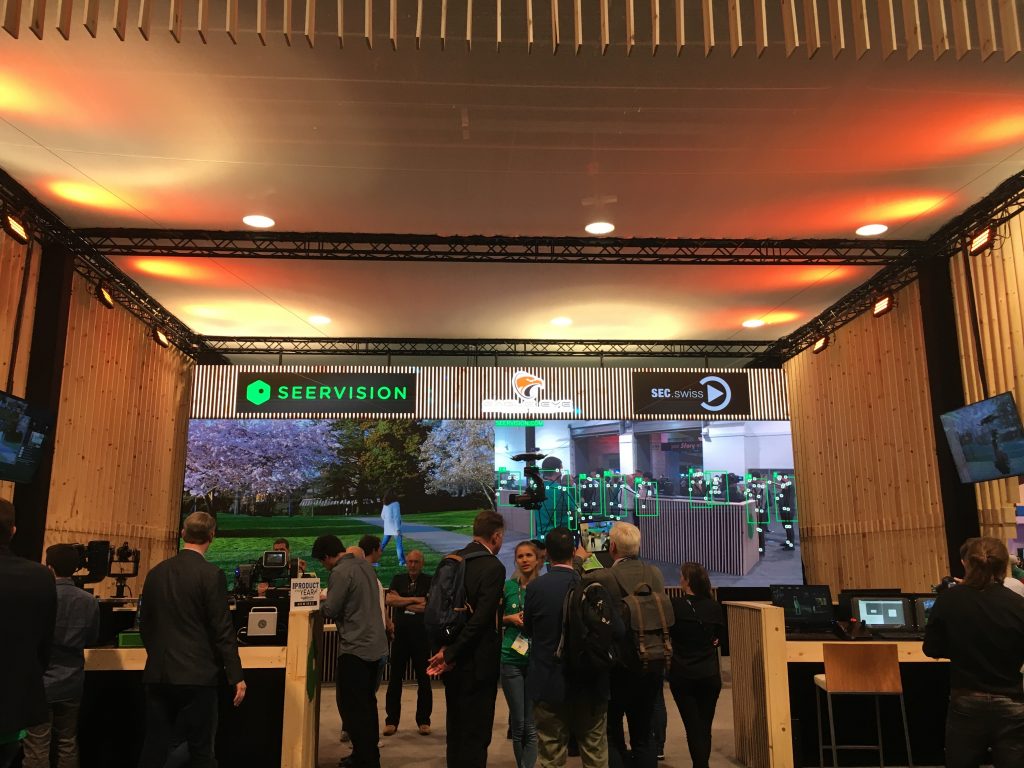
Social Media: This also didn’t exist back then. Today it almost seems old school to be doing regular social media posting about your tradeshow appearance. I mean, even Grandma is on Instagram, right? But social media is still a good way to post photos, respond to comments and let your followers know what’s going on while your company is exhibiting.
Last time when you set up your tradeshow exhibit and lived in it for a few days, did it feel cramped? Were you wishing you had another table to sit down at with potential clients? Trying to cram too many products on too few shelves?
Maybe it’s time for a new exhibit. So what’s holding you back?
It might be finances. Certainly that’s one of the biggest things that holds any company back. But beyond money, are you moving out of your comfort zone? It happens frequently. Many clients we work with at TradeshowGuy Exhibits have been using banner stands and pop-ups, which transport easily and take just a few moments to set up. Nothing wrong with that, but these companies have grown enough that they can afford a larger exhibit, one that not only looks good to give their brand a brand new look, but because it’s more complicated it needs to ship in a wooden crate using semi-trucks, it will likely need to be set up by an I&D (installation/dismantle) management crew.
And yes, that moves many companies beyond their comfort zone. Having been down that road with a lot of companies, we often help navigate that path.
But if it’s money, there are ways to convince the purse holders that it’s time to invest in a new booth.
First, consider what would happen if you did nothing for the next 2-3 years. Your exhibit would be a few years older. Many of your competitors might already have upgraded to a new exhibit which will look a lot sharper than yours. How will your visitors then perceive your company compared to those competitors? Remember that perception counts a lot, and almost nowhere does it count as much as it does at tradeshows. Visitors there see you at your finest. And if your finest comes up short from what you want and what your visitors think you should be, that could be a problem.
Then again, maybe a new exhibit isn’t the answer. You might be better off investing in booth staff training. Or pre-show marketing. By doing this, you can still crank up the ROI on your tradeshow marketing investment and put off the exhibit investment for a couple more years.
But if you are seriously considering a new exhibit, think about who it will impact and how. Where will you store it? How much will it cost to ship or setup and dismantle?
Understand how much time you’ll need to design and fabricate the exhibit by talking to experience exhibit builders. Your new exhibit will last you several years, maybe 5 to 7 or more depending on the type of exhibit and how you use it.
Once you’ve decided that it’s a good move to pitch the powers-that-be, be prepared. Contact a few exhibit houses to understand their processes and timelines required, along with budget ranges for the size and type of exhibit you’re considering.
Make a written description of the exhibit requirements. When pitching the boss, offer a reasonable price range for the project, how long it’ll take to amortize the cost (3, 5, 7+ years), do your best to explain how the next exhibit will increase your lead generation (three clients in the past three years have told us that the increased size of the exhibit and the newness of it tripled their leads at the first show!).
Show the “soft” return on the exhibit, such as the impact the new look will have on your current customers who see the positive direction your company is taking. Or on the employees, who see the same thing. There are a lot of things that might be holding you back from investing in a new exhibit. But with careful planning and working with the right partners, you can create an environment and a situation where the new exhibit can become a reality.
Less than three weeks after a just-completed tradeshow, I heard from an exhibitor I’d met at the show. He was interested in looking at doing something new for next year’s show, which was still more than eleven months away.
I commended him for being on top of it! His response was that they waited too long last time around and they didn’t want to let it happen again next year.
So what can you do now that this year’s big expo show is over to prepare for next year’s show, even though it’s almost a year away? Let’s count a few:
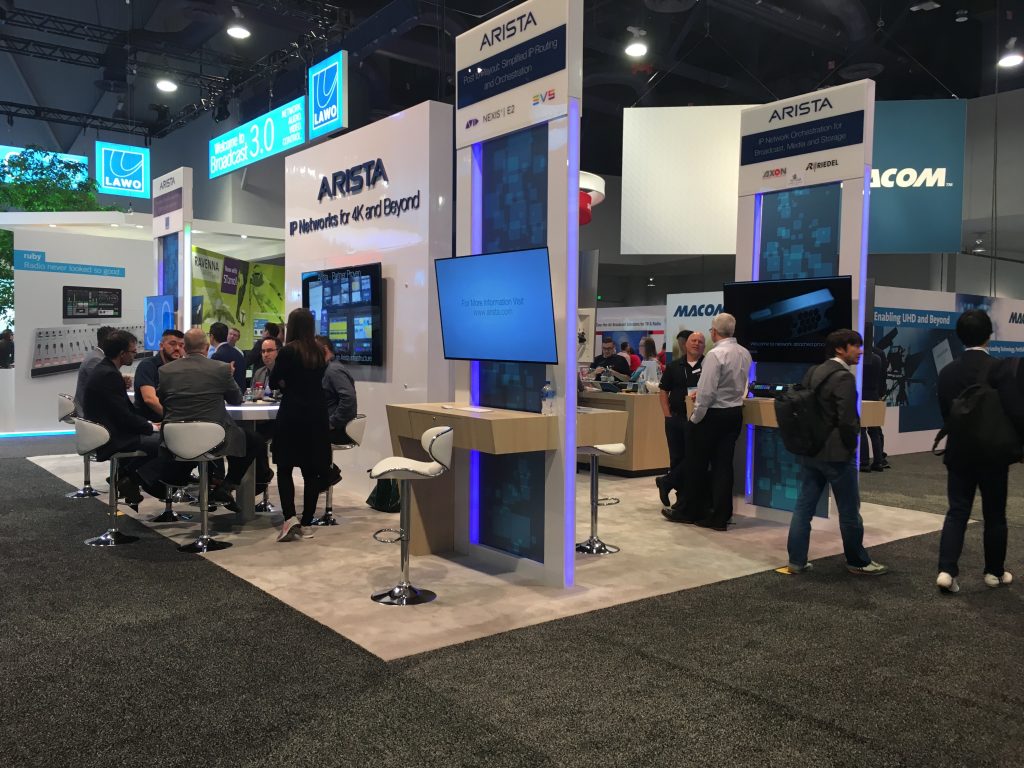
Plan ahead. Seems simple. But so many companies I talk to end up waiting until the last moment. There is no urgency to act until the dates in the calendar are nearer than you thought possible! Reach out to the various entities you may end up working with, whether it’s a current exhibit house, design house, graphic designer or whomever, and discuss your plans. You’ll get a sense of how much time things take which will give you much-needed information to put together a workable plan.
Find out what things will cost. In the case of a new exhibit, not just updating graphics on a current exhibit, you’ll need to determine how much the investment might be. There are industry averages, there’s your budget, and there’s your wish list. At some point these will all have to meet in the middle. If you’re unsure of how much your budget is, and how much things might cost, the sooner you gather that information the better prepared you’ll be as you move forward. Learning the cost of a potential new booth helps craft and shape the budget. Knowing your budget helps craft the final design.
Determine to the best of your ability what products and services you’ll be promoting. In most cases, clients we work with put this off until much closer to the show mainly because they want to have a handle on what will be available for sampling, when products or services launch and so on. At this point in your design discussions, you will likely leave placeholder graphics in place. But knowing if you have eight new products, or three, or fifteen, will help the direction of the design.
If you are not sure if you’ll continue to work with your current exhibit house, talk to several vendors. Each one will offer strengths and advantages; some will have obvious weaknesses for your specific goals. Learn as much as possible about them, speak to their current clients, learn about how the process went. Some companies will be a good fit and others won’t – there’s no real right and wrong. Often, it’s just a feeling, but feelings are important. All things being equal, people like doing business with people they like and get along with.
Take your time. If you’re more than half a year out, you have lots of time to ponder things. Run ideas by other people. Brainstorm some in-booth activities. Research what’s worked for others. The more time you are able to take, the more comfortable you’ll be with the decisions you finally reach. That doesn’t necessarily mean you’ll take a lot of time making decisions. Some people make snap decisions that are absolutely right. Maybe that’s you.
Finalize the plan. Get the various entities (vendors, designers, booth staff) lined up and make sure they’re all on board with the plan. Confirm the timeline, and add in a little buffer time for unexpected circumstances.
Once the show is underway next year with few to no glitches, congratulate yourself for getting so far ahead of the project!
When you ring up your custom exhibit house and order a new custom tradeshow exhibit, do you ever consider your company’s sustainability initiative?
Of course, there are a lot of things that can go into a company-wide sustainability initiative, such as having it as part of your company mission, doing your best to reduce waste through recycling, using less power, automate workflow or whatever else that may fit, making sure your employees are engaged in the process, and having ways to measure the effectiveness of the program so you can show it off to both employees and the public.
But do you consider how a new exhibit can possibly help in your efforts? There are a number of ways to use the opportunity of a new exhibit project as a part of your sustainability efforts.
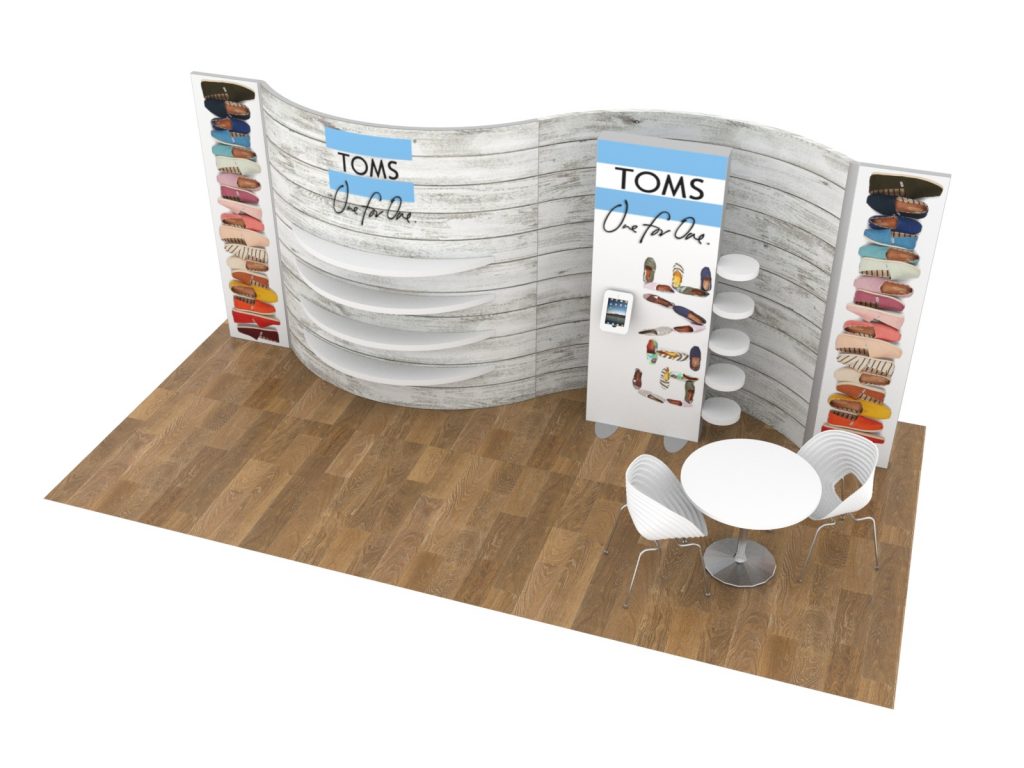
First, you have to ask the question. When you are chatting with your exhibit house representative, ask them: “What ways do you implement sustainability efforts in your exhibit-design and building projects?”
That gives them a chance to show their stuff. In my experience, it’s rarely asked. But it is occasionally brought up, particularly in regard to responding to an RFP. The more formalized the process, it seems, the better the chance to have the question pop up. That’s where a company can fully respond to those concerns.
There have been some occasions when the question is asked as part of the conversation leading up to the sale, or as part of the project, but it is rarer in my experience.
Which is a shame. I think the buying / selling dance is a great chance (often a missed chance) to explore ways in which an exhibit company uses sustainability efforts to great effect.
For example, we often work with Classic Exhibits, one of the premier exhibit builders in the nation. They’re well-known in the industry for the depth and breadth of their sustainable practices. Just one example: aluminum is smelted and extruded locally in Portland, not shipped in, and recycled a short distance away to keep transportation costs minimal. Their approach to sustainability includes the ability to recycle everything except Sintra. That includes wood, aluminum and other metal, paper, foam, clear film and clear film plastic. All except wood is recycled at no cost.
Another Portland example, Boothster, uses building materials that are very easy to recycle: carboard tubes, cardboard-printed pieces, bamboo banner stands and so on. They position their company as builders that fully adhere to the practices for sustainability.
Greenspace, also in Portland, positions their approach as “environmentally sustainable design and fabrication.”
Another builder we work with at TradeshowGuy Exhibits, Eco-Systems Sustainable Exhibits, approachas the design and fabrication of exhibits using materials such as recycled aluminum extrusions, LED lighting, ECO-glass made from 100% post-industrial recycled content, bamboo plywood, FSC certified wood, plastic shipping cases made from recycled plastics and are 100% recyclable. Graphics are printed on ECO-board, Paradise fabric (made from 100% recycled soda bottles), and finishes are water-based low VOC (volatile organic compound) or VOD-free, and Greenguard certified.
All of these go a long way to making your tradeshow investment dollars be a part of your commitment to a company-side sustainability initiative.